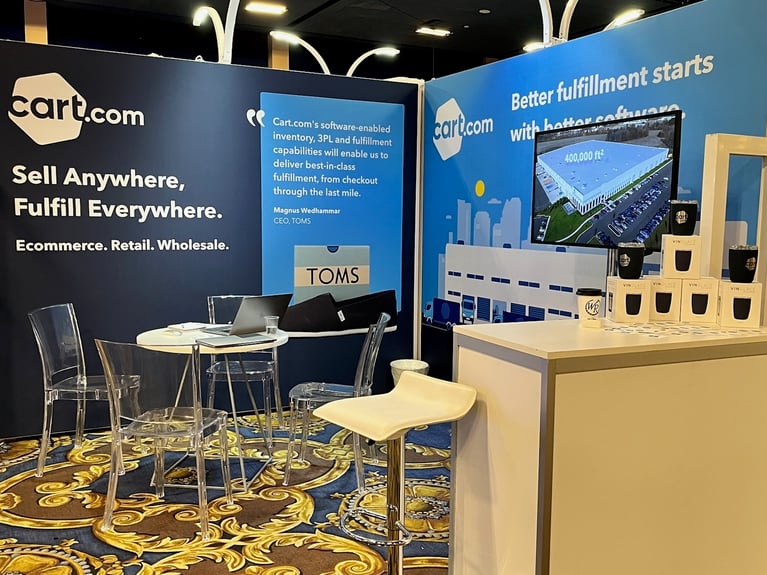Originally posted June 8, 2023, updated May 8, 2024 by A. Wolfe.
B2B ecommerce is no longer an emerging channel. In fact, according to McKinsey, 65% of B2B companies are already engaged in ecommerce, and over 18% of the average B2B company's revenue is generated via ecommerce.
Despite the increasing importance of B2B ecommerce, several challenges hinder even mature companies from being able to extract maximum value out of their digital commerce strategy. And while there are a variety of software tools that exist to help facilitate B2B ecommerce, the physical and logistical aspects of ecommerce can be difficult for B2B companies to master. For example, in some cases, B2B organizations may have their own warehouse or storage facilities. Unfortunately, these assets are often not optimally configured for ecommerce and frequently lack the appropriate software to fully connect online points of sale to fulfillment operations and order data to inventory data.
Below, we capture five of the most common challenges B2B brands encounter and the approaches recommended to overcome them.
1. Inventory management: Optimizing amid supply chain uncertainty
Inventory management is a vital commerce discipline — one that is particularly important for B2B companies given the unique volume, minimums, lead time, purchase cycle and supply chain considerations B2B companies have. Maintaining optimal inventory levels across SKUs is essential to meet customer demand (which in some industries have become less predictable) while minimizing carrying costs. However, many companies struggle to strike the right balance, leading to costly problems such as excess stock or stockouts.
While companies may look to processes improvements to address these issues, technology also plays the pivotal role in optimizing inventory levels and achieving full supply chain visibility. The right software tools can help you track inventory in real-time, identify and predict demand patterns, improve fulfillment outcomes, manage labor levels and provide insight into what SOPs and other processes should be modified to further optimize inventory levels. Today, AI-driven analytics and forecasting tools can help you see the future and reduce stockouts and overstock situations, helping you cut costs and maximize revenue.
Whether your inventory tech stack is comprised of one solution or a few, it’s vital that they seamlessly integrate. Otherwise, you could experience a proliferation of costly middleware applications and connectors or be forced to custom build the data pipelines between each solution and every other solution (many to many integration).
2. Order-to-cash: Automating a cumbersome process
B2B companies often have cumbersome order-to-cash processes that in some cases may still rely on manual, analog or last-generation tools to take a customer order, fulfill that order and collect payment. Customer frustration due to a suboptimal order-to-cash process is a scenario that is all too common for even the best, most trusted companies.
Fortunately, integrated order management systems and automation tools that support ecommerce use cases and connect to billing and accounting systems can significantly streamline the ecommerce order-to-cash process. These technologies automate order processing, invoicing and payment collection, reducing human error and speeding up transactions.
While you may be inclined to use the tools you use to support your non-ecommerce business, there will be features, integrations and data points specific to ecommerce that will be vital to success. That’s why for B2B companies, more enterprise-grade systems that can be integrated across your ecommerce and non-ecommerce application stacks are critical to ensure you don’t have siloed processes for billing, fulfilling and collecting.
3. Stockouts: The curse of inaccurate forecasting
Stockouts result in both missed sales opportunities and frustrated customers. Inaccurate demand forecasting is a common root cause of this issue, as companies struggle to anticipate and plan for customer needs effectively. This challenge is particularly acute for B2B companies that may have order minimums, bulk volumes, complex pricing and stringent lead times that make it difficult to spot trends and proactively manage inventory to avoid stockout situations.
Many companies have traditionally relied on historical data to predict future demand and inventory levels. Today, however, new Artificial Intelligence and Machine Learning based tools are available that can use a myriad of real-time sources from marketing and advertising data to website traffic to shipping data to improve and extend forecasts. By utilizing data-rich, AI-driven forecasting techniques, companies can minimize stockouts and ensure the availability of high-yielding products. Moreover, modern tools also allow B2B companies to understand the cost of stockouts and overstock situations, which can help you analyze tradeoffs and make better inventory purchasing and new product development decisions.
AI is a trending topic. Many companies are still wrestling with how to take advantage of it. What better way than to harness AI to power your inventory forecasting and demand planning functions.
4. Expertise: Focus on your core competencies
Let’s face it, logistics, distribution and fulfillment may not be your core competency. That’s why many large B2B and B2C companies rely on 3PLs to help them navigate the world of freight, transportation, storage, distribution and fulfillment. It’s also costly to operate your own warehouse facilities and purchase the requisite hardware and software to run them efficiently. If ecommerce logistics is something new or daunting for your B2B enterprise, don’t let that discourage you from embracing digital commerce. Let a 3PL come alongside and take the parts of the supply chain you don’t want to deal with off your plate.
By partnering with experts, B2B companies can leverage our expertise in distribution, logistics and order fulfillment. With state-of-the-art warehousing facilities, advanced inventory management systems and a veteran workforce to handle the complexities of order processing and delivery, contract logistics providers allow companies to focus on their core strengths, while lowering ongoing operational cost and reducing risk.
5. Expansion: Mitigating risk of expansion
As a B2B business grows, the costs associated with expansion can become a significant hurdle. Purchasing new warehouses, managing capital investments and ensuring operational efficiency in multiple locations can drain financial resources and increase operational complexity. This is especially true for companies whose purchase cycles mean their warehouse needs fluctuate dramatically from month to month. It’s not economically viable to carry facilities and labor that isn’t completely utilized.
With the uncertain economic future, outsourcing warehousing and distribution to experts can alleviate the financial burden and risks associated with expansion. B2B brands can benefit from a strategic partner – accessing buying power, freight rates, a geographic footprint and labor synergies that a single company could not.
Leveraging a 3PL is also extremely beneficial to counter the impact of seasonality, enabling you to flex up or down depending on demand. By leveraging existing infrastructure, B2B companies can avoid substantial capital investments while benefiting from at-scale capabilities. This approach allows companies to focus on expanding their market presence and product offerings without compromising financial stability.
Cart.com for your B2B ecommerce needs
B2B ecommerce has revolutionized the way businesses operate, but it also presents unique challenges that must be addressed for sustained growth. By leveraging technology for inventory optimization, streamlining the order-to-cash process, and improving forecasting capabilities, companies can overcome these obstacles. Moreover, partnering with distribution experts like Cart.com allows businesses to focus on their core competencies while ensuring efficient warehousing and order fulfillment, and our customers benefit from our economies of scale. By embracing these solutions, B2B companies can enhance their ecommerce operations, deliver superior customer experiences, and drive success in the digital marketplace. Contact our experts today to find out how we can help you.

-1.webp?width=400)






